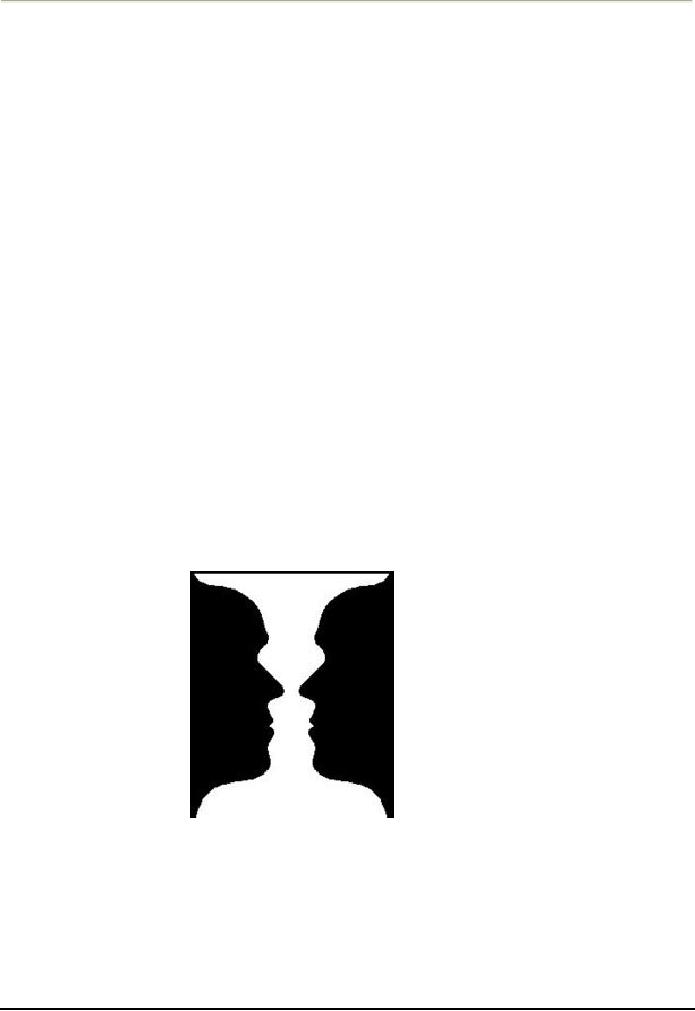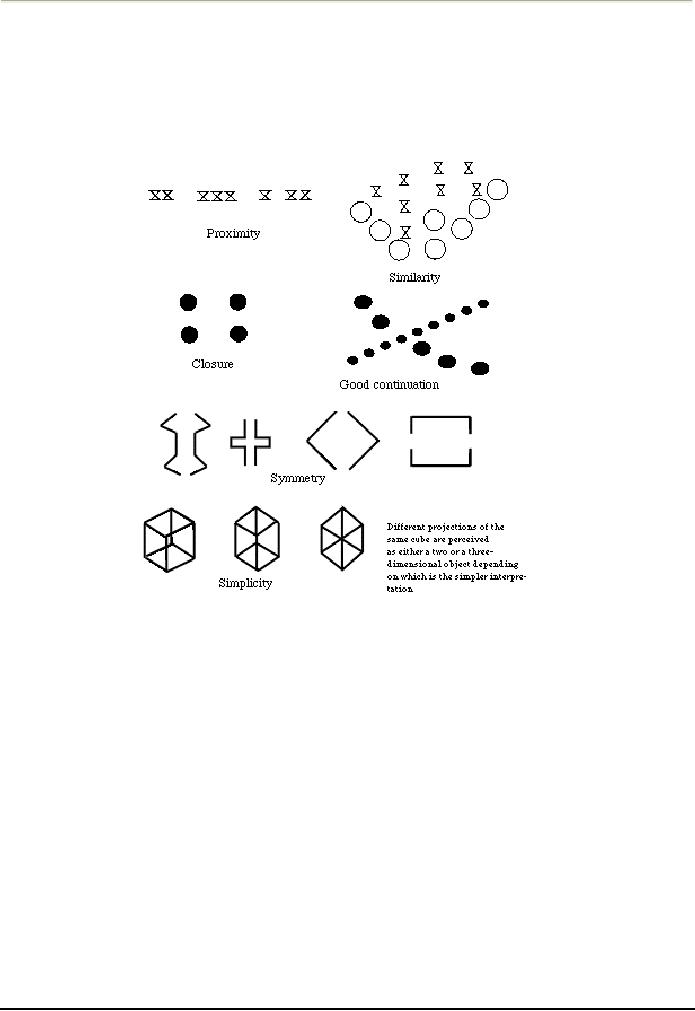 |

Organizational
Psychology (PSY510)
VU
LESSON
12
PERCEPTION
Perception
may be
defined as the process of acquiring,
interpreting, selecting, and organizing
sensory
information.
The word perception comes
from the Latin capere,
meaning "to take," the prefix
per meaning
"completely."
Methods of studying perception range from
essentially biological or physiological
approaches,
through
psychological approaches through the
philosophy of mind.
In
short, perception is a very complex cognitive process
that yields a unique picture of the
world, a picture
that
may be quite different from
reality. In terms or organizational psychology,
perception plays the role of
creating
a picture for the employee based on
his or her own thinking. Therefore, the
same situations/stimuli
may
produce very different reactions
and behaviours from
different employees. Understanding
the
difference
between this perceived image
and the real image is imperative to
understand behaviour of
employees.
The perceptual image of the
manager may be quite
different from the perceptual
image of the
employee,
and both may be very
different from
reality.
Sensations
and Perceptions
Sensations
can be defined as the passive
process of bringing information
from the outside world into
the
body
and to the brain. The process is
passive in the sense that we do
not have to be consciously
engaging in
a
"sensing" process.
Perception
can be defined as the active
process of selecting, organizing, and
interpreting the information
brought
to the brain by the senses.
How
They Work Together
Sensation
occurs when:
a)
Sensory organs absorb energy
from a physical stimulus in the
environment.
b)
Sensory receptors convert this
energy into neural impulses
and send them to the brain.
Perception
follows:
a)
The brain organizes the
information and translates it
into something meaningful.
You
may look at a painting and
not really understand the
message the artist is trying to convey.
But, if
someone
tells you about it, you
might begin to see things in the painting
that you were unable to see
before.
All
of this is called Psychophysics
Psychophysics
can be defined as, the study
of how physical stimuli are
translated into
psychological
experience.
In order to measure these
events, psychologists use
Thresholds. Threshold is a dividing
line
between
what has detectable energy
and what does not. For
example - many classrooms
have automatic
light
sensors. When people have
not been in a room for a
while, the lights go out. However, once
someone
walks
into the room, the lights go back
on. For this to happen, the
sensor has a threshold for
motion that
must
be crossed before it turns the lights back
on. So, dust floating in the
room should not make the
lights
go
on, but a person walking in
should.
Perceptual
Organization
Organizing
raw sensory stimuli into
meaningful experiences involves
cognition, a set of mental
activities
that
includes thinking, knowing,
and remembering. Knowledge
and experience are extremely
important to
perception,
because they help us make
sense of the input to our
sensory systems.
Gestalt
Laws of Grouping
How
people perceive a well-organized pattern or whole,
instead of many separate
parts, is a topic of
interest
in
Gestalt psychology. According to Gestalt
psychologists, the whole is different
than the sum of its
parts.
Gestalt
is a German word meaning configuration or
pattern.
A
major goal of Gestalt theory in the 20th
century was to specify the
brain processes that might
account for
the
organization of perception. Gestalt theorists, chief
among them the German-U.S. psychologist
and
philosopher,
the founder of Gestalt theory, Max
Wertheimer and the German-U.S.
psychologists Kurt
Koffka
and Wolfgang K�hler, rejected the
earlier assumption that
perceptual organization was the
product
of
learned relationships (associations), the constituent
elements of which were
called simple
sensations.
Although
Gestaltists agreed that
simple sensations logically could be understood to
comprise organized
percepts,
they argued that percepts
themselves were basic to
experience. One does not
perceive so many
discrete
dots (as simple sensations),
for example; the percept is
that of a dotted line.
Without
denying that learning can play some
role in perception, many theorists
took the position
that
perceptual
organization reflects innate properties of the brain
itself. Indeed, perception and brain
functions
42

Organizational
Psychology (PSY510)
VU
were
held by Gestaltists to be formally identical
(or isomorphic), so much so that to
study perception is to
study
the brain. Much contemporary research in
perception is directed toward inferring
specific features of
brain
function from such behavior
as the reports (introspections) people give of their
sensory experiences.
More
and more such inferences
are gratifyingly being matched
with physiological observations of the
brain
itself.
Many
investigators relied heavily on introspective reports,
treating them as though they were
objective
descriptions
of public events. Serious doubts
were raised in the 1920s
about this use of introspection by
the
U.S.
psychologist John B. Watson and
others, who argued that it
yielded only subjective accounts
and that
percepts
are inevitably private
experiences and lack the
objectivity commonly required of scientific
disciplines.
In response to objections about
subjectivism, there arose an
approach known as
behaviorisms
that
restricts its data to objective
descriptions or measurements of the overt
behavior of organisms
other
than
the experimenter himself.
Wertheimer
(1923) studied some factors
which influence grouping in images, the
so called Gestalt
Principles of
Perceptual
Organization. He
identified the following grouping
factors
Figure
and Background
Not
only does perception involve organization
and grouping, it also
involves distinguishing an object
from
its
surroundings. Notice that
once you perceive an object, the
area around that object becomes
the
background.
Gestalt psychologists have devised
ambiguous figure-ground relationships -
that is, drawings in
which
the figure and ground can be
reversed - to illustrate their point
that the whole is different
from the
sum
of its parts. The "figure
and ground" illusion is commonly
experienced when one gazes
at the
illustration
of a black vase the outline of
which is created by two
white profiles. At any moment one
will be
able
to see either the black vase
(in the centre area) as
"figure" or the white profiles on
each side (in
which
case
the black is seen as "ground").
The fluctuations of figure
and ground may occur
even when one fails
deliberately
to shift attention, appearing
without conscious effort.
Seeing one aspect apparently
excludes
seeing
the other.
Although
such illustrations may fool
our visual systems, people
are rarely confused about what they
see. In
real
world, vases do not change
into faces as we look at
them. Instead, our perceptions
are remarkably
stable.
The Gestaltist's concept is
"figure-ground segregation" is not
only referring to
foreground-
background,
but also covers situations,
e.g., in which you look
through a window outside at a
tree. The
frame
of the window is then the ground the
tree the "figure", although it is
behind the "ground."
Proximity
Objects
that are close to each
other in physical space are
often perceived as belonging together.
This is the
law
of proximity or closeness. In the figure
below, proximity results in a
grouping containing pairs of
dots.
Similarity
This
law states that objects
that are similar are
perceived as going together. For example,
if I ask you to
group
the following objects: (* * # * # # #)
into groups, you would
probably place the asterisks
and the
pound
signs into distinct
groups.
43

Organizational
Psychology (PSY510)
VU
Continuity
of Direction
There
is a tendency in our perception to follow
a direction, to connect the elements in a
way that makes
them
seem contiguous or flowing in a particular
direction We follow whatever
direction we are led.
.
Dots in a smooth curve appear to go
together more than jagged
angles. This principle really gets at
just
how
lazy humans are when it
comes to perception.
Closure
There
is a tendency in our perception to
complete incomplete figures, to fill in
gaps. And units forming
a
closed
figure tend to be perceived
together. We actually tend to
complete a form when it has
gaps.
Simplicity/Pragnanze
We
group elements that make a
good form. However, the idea
of "good form" is a little
vague and
subjective.
Most psychologists think
good form is what ever is
easiest or most simple. For
example, what do
you
see here: : > ) do you see a smiling
face? There are simply 3
elements from my keyboard next to
each
other,
but it is "easy" to organize the
elements into a shape that
we are familiar with or
which is meaningful.
Perceptual
Selection
From
a purely biological standpoint
our senses are utilized to
perceive the world around us and to
help us
learn
about it (Kerby, 1975). We take in
stimuli from this world by
tasting, touching, smelling, hearing
and
seeing
what's going on around us. Since
stimulation comes at us from
several directions at once, we
have
the
biological capability to physically 'tune
out' most of what we do not
need for the task at
hand.
The
human body receive a number of stimuli.
The noise of the environment, the
sound of the home
appliances
etc. are a few of the stimuli affecting
the senses plus the impact of the
total environmental
situation.
Sometimes the stimuli are
below the person's conscious threshold, a
process called subliminal
perception. Despite the
presence of all these stimuli,
only few are registered by the
body. Why it happens
can
be explained as follows:
The
principles of perceptual selection
involve two types of
factors:
�
Objective
Factors
44

Organizational
Psychology (PSY510)
VU
�
Subjective
Factors
Objective
Factors
Intensity
According
to this principle, the more intense the
stimulus, more its chances
of being perceived. A loud
noise
is more likely to be perceived as
compared to a softer one.
Size
According
to this principle, the larger the object, the
more likely it will be
perceived. The tallest
building in a
bird-eye
view of a city is more
likely to be perceived than a smaller
one.
Contrast
This
principle states that external
stimuli that stand out
against the background will receive
greater attention.
For
example, warning signs on road with
black colour on yellow background
are based on the principle
of
contrast.
Repetition
Repeated
external stimulus is more attention
getting than a single one. Advertisement
efforts are often
based
on same principle.
Motion
Vs stationary
The
motion principle says that
people pay more attention to
moving objects in the field of
vision than they
will
to stationary objects.
Novelty/familiarity
The
novelty familiarity principle
states that either a novel or a
familiar external situation can serve
as
attention
getter
Subjective
factors
Motivation
and Habits
Motivation
and habits play a vital role
in determining the perceptions of individuals in an
organization. In
most
cases, however, learning motivation and
personality lead to extreme individual
difference s because of
the
way the individual is set to
perceive. People may make
wrong perceptions or perceive the
same stimulus
or
stimulation in entirely different
ways.
REFERENCES
�
Ehrenstein,
W. (1930). Untersuchungen �ber Figur-Grund-Fragen.
Zeitschrift
f�r Psychologie, 117,
339-412.
�
History
of study of perception.
http://en.wikipedia.org/wiki/Perception#History_of_the_study_of_perception#History_of_the_stud
y_of_perception
FURTHER
READING
�
Theory
of figure and ground:
http://en.wikipedia.org/wiki/Figure-ground
�
Study
of optical illusions and its
principles:
http://www.sapdesignguild.org/resources/optical_illusions/intro_principles.html#gestalt_laws#gestalt
_laws
45
Table of Contents:
- INTRODUCTION TO ORGANIZATIONAL PSYCHLOGY:Hawthorne Effect
- METHODOLOGIES OF DATA COLLECTION:Observational method, Stability of Measures
- GLOBALIZATION:Aspects of Globalization, Industrial Globalization
- DEFINING THE CULTURE:Key Components of Culture, Individualism
- WHAT IS DIVERSITY?:Recruitment and Retention, Organizational approaches
- ETHICS:Sexual Harassment, Pay and Promotion Discrimination, Employee Privacy
- NATURE OF ORGANIZATIONS:Flat Organization, Neoclassical Organization Theory
- ORGANIZATIONAL CULTURE:Academy Culture, Baseball Team Culture, Fortress Culture
- CHANGING ORGANIZATIONAL CULTURE:Move decisively, defuse resistance
- REWARD SYSTEMS: PAY, Methods of Pay, Individual incentive plan, New Pay Techniques
- REWARD SYSTEMS: RECOGNITION AND BENEFITS, Efficiency Wage Theory
- PERCEPTION:How They Work Together, Gestalt Laws of Grouping, Closure
- PERCEPTUAL DEFENCE:Cognitive Dissonance Theory, Stereotyping
- ATTRIBUTION:Locus of Control, Fundamental Attribution Error
- IMPRESSION MANAGEMENT:Impression Construction, Self-focused IM
- PERSONALITY:Classifying Personality Theories, Humanistic/Existential
- PERSONALITY ASSESSMENT:Standardized, Basic Categories of Measures
- ATTITUDE:Emotional, Informational, Behavioural,Positive and Negative Affectivity
- JOB SATISFACTION:The work, Pay, Measurement of Job Satisfaction
- MOTIVATION:Extrinsic motive, Theories of work motivation, Safety needs
- THEORIES OF MOTIVATION:Instrumentality, Stacy Adams’S Equity theory
- MOTIVATION ACROSS CULTURES:Meaning of Work, Role of Religion
- POSITIVE PSYCHOLOGY:Criticisms of ‘Traditional’ Psychology, Optimism
- HOPE:Personality, Our goals, Satisfaction with important domains, Negative affect
- EMOTIONAL INTELLIGENCE:EI IS Related To Emotions and Intelligence
- SELF EFFICACY:Motivation, Perseverance, Thoughts, Sources of Self-Efficacy
- COMMUNICATION:Historical Background, Informal-Formal, Interpersonal Communication
- COMMUNICATION (Part II):Downward Communication, Stereotyping Problems
- DECISION MAKING:History, Personal Rationality, Social Model, Conceptual
- PARTICIPATIVE DECISION MAKING TECHNIQUES:Expertise, Thinking skills
- JOB STRESS:Distress and Eustress, Burnout, General Adaptation Syndrome
- INDIVIDUAL STRESSORS:Role Ambiguity/ Role Conflict, Personal Control
- EFFECTS OF STRESS:Physical Effects, Behavioural Effects, Individual Strategies
- POWER AND POLITICS:Coercive Power, Legitimate Power, Referent Power
- POLITICS:Sources of Politics in Organizations, Final Word about Power
- GROUPS AND TEAMS:Why Groups Are Formed, Forming, Storming
- DYSFUNCTIONS OF GROUPS:Norm Violation, Group Think, Risky Shift
- JOB DESIGN:Job Rotation, Job Enlargement, Job Enrichment, Skill Variety
- JOB DESIGN:Engagement, Disengagement, Social Information Processing, Motivation
- LEARNING:Motor Learning, Verbal Learning, Behaviouristic Theories, Acquisition
- OBMOD:Applications of OBMOD, Correcting Group Dysfunctions
- LEADERSHIP PROCESS:Managers versus Leaders, Defining Leadership
- MODERN THEORIES OF LEADERSHIP PROCESS:Transformational Leaders
- GREAT LEADERS: STYLES, ACTIVITIES AND SKILLS:Globalization and Leadership
- GREAT LEADERS: STYLES, ACTIVITIES AND SKILLS:Planning, Staffing